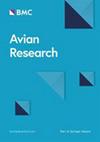Dynamic evolution of olfactory receptor genes in the Turkey Vulture and Black Vulture
IF 1.7
2区 生物学
Q1 ORNITHOLOGY
引用次数: 0
Abstract
Olfactory receptors (ORs), the largest vertebrate multigene family, exhibit wide copy number variation among taxa, ranging from ∼100 to 4000. The ecological importance of smell has been suggested to positively correlate with OR gene number, though debate exists on whether the number of total ORs, functional ORs, or the percentage of pseudogenes matters most. While olfaction has been poorly studied in most birds, Turkey Vultures (Cathartes aura) demonstrate keen olfactory ability, capable of foraging using smell alone. In contrast, Black Vultures (Coragyps atratus) have been thought to primarily use vision to locate food. Comparison of the OR genes in these two New World vultures presents an opportunity to examine the dynamics of OR evolution in related avian species that may differ in olfactory abilities. Using a PCR and cloning approach with degenerate primers, we sampled the OR subgenome in Turkey and Black Vultures, as well as Red-tailed Hawks (Buteo jamaicensis) and the distantly related Chicken (Gallus gallus), neither of which are thought to use olfaction extensively. Our results indicate that Turkey Vultures have many more OR genes than Red-tailed Hawks or chickens. Surprisingly, Black Vultures had an intermediate number of OR genes. The number of OR genes we estimated in the Turkey Vulture was much greater than previously reported in studies that used short-read sequencing. Additionally, we found that OR genes from New World vultures and Red-tailed Hawks form clades that were distinct from the clade that included most chicken OR genes, indicating that chickens share few OR orthologs with New World vultures or hawks. As previously observed in other animal groups, pseudogenes appeared throughout all clades and their percentage varied among taxa. These findings suggest the OR gene family is highly dynamic, changing rapidly over evolutionary time, and that taxa may have distinct suites of ORs in their genomes.
土耳其秃鹫和黑秃鹫嗅觉受体基因的动态进化
嗅觉受体(Olfactory receptors, ORs)是脊椎动物中最大的多基因家族,在不同的分类群中表现出广泛的拷贝数差异,从100到4000不等。嗅觉的生态重要性已被认为与OR基因数量呈正相关,尽管存在关于总OR数量、功能OR数量或假基因百分比最重要的争论。虽然大多数鸟类的嗅觉研究很少,但土耳其秃鹫(Cathartes aura)表现出敏锐的嗅觉能力,能够仅凭嗅觉觅食。相比之下,黑秃鹫(Coragyps atratus)被认为主要利用视觉来定位食物。通过比较这两种新大陆秃鹫的OR基因,我们有机会研究嗅觉能力不同的相关鸟类物种的OR进化动态。利用聚合酶链反应(PCR)和退化引物克隆方法,我们对土耳其和黑秃鹫,以及红尾鹰(Buteo jamaicensis)和远亲鸡(Gallus Gallus)的OR亚基因组进行了采样,这两种动物都不被认为广泛使用嗅觉。我们的研究结果表明,土耳其秃鹫比红尾鹰或鸡有更多的OR基因。令人惊讶的是,黑秃鹫有中等数量的OR基因。我们在土耳其秃鹫中估计的OR基因数量远远大于之前使用短读测序的研究报告。此外,我们发现来自新大陆秃鹫和红尾鹰的OR基因形成的分支与包含大多数鸡OR基因的分支不同,这表明鸡与新大陆秃鹫或鹰的OR同源物很少。与以前在其他动物类群中观察到的一样,假基因出现在所有的进化枝中,其百分比在不同的分类群中有所不同。这些发现表明OR基因家族是高度动态的,随着进化时间的推移而迅速变化,并且分类群可能在其基因组中具有不同的OR套件。
本文章由计算机程序翻译,如有差异,请以英文原文为准。
求助全文
约1分钟内获得全文
求助全文
来源期刊

Avian Research
ORNITHOLOGY-
CiteScore
2.90
自引率
16.70%
发文量
456
审稿时长
46 days
期刊介绍:
Avian Research is an open access, peer-reviewed journal publishing high quality research and review articles on all aspects of ornithology from all over the world. It aims to report the latest and most significant progress in ornithology and to encourage exchange of ideas among international ornithologists. As an open access journal, Avian Research provides a unique opportunity to publish high quality contents that will be internationally accessible to any reader at no cost.
 求助内容:
求助内容: 应助结果提醒方式:
应助结果提醒方式:


